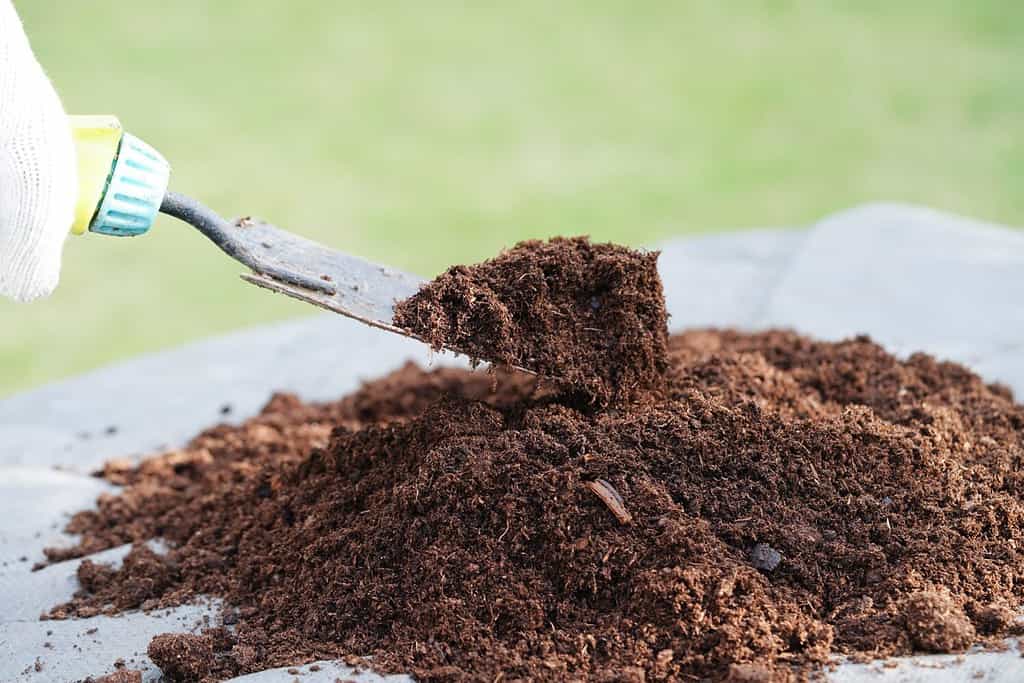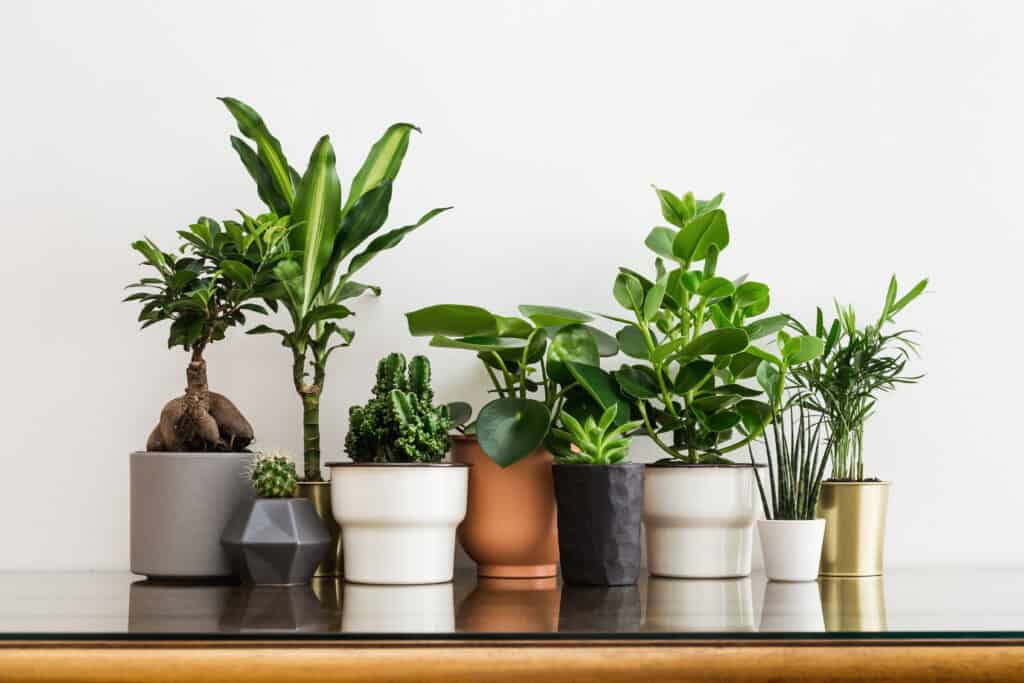Houseplants come in a wide variety of shapes and sizes. Their benefits include the ability to improve our air quality and reduce stress. In addition, they offer decorators a living design element. Besides, looking at them makes us happy, and caring for them gives us a sense of pride. For them to thrive they, like us, need the proper nutrients and environment. Therefore, selecting the correct potting soil provides a healthy home for them to grow. Pre-made potting soil or mix is available from the store. However, some gardeners like to have control over their mixes, and not all houseplants like the same soil.
Different plants have unique needs such as temperature, light, water, and soil, knowing their particular requirements can make or break the health of a plant. Soil pH measures from zero to 14, the most acidic to most alkaline respectively. The pH of soil affects the amount of nutrients a plant receives and ultimately shows in their growth and health. In fact, most houseplants do well in the six to seven pH range, a soil test kit or meter can provide readings to ensure proper levels are maintained. Adding sulfur lowers pH and limestone increases it when changes need to be made.
Soil supports and protects the plant’s root system; they do their best when there is space for the roots and proper drainage and aeration. Soil contains nutrients for about the first 6 weeks, after that plants will need new nutrients in the form of weekly fertilizing which should begin in the spring through summer months. Spring is the best time to repot if your plant outgrows its space. In this article we will review what makes up the 10 best potting soil options for indoor plants, how to make your own planting mix, and some additional tips.
Different Types of Potting Soil

Peat moss consists of sphagnum moss and other decomposed organic materials from peat bogs.
©sweet_tomato/Shutterstock.com
Not all plants have the same potting soil requirements and will need a specific mixture to provide the nutrients and ideal environment for them to grow. Accordingly, these are some of the 10 best potting soil options for indoor plants and their benefits:
- Sand: improves drainage
- Limestone: neutralizes acidity and regulates pH levels
- Compost: optimizes drainage and adds broken-down organic matter
- Coco coir or coconut husk: made from shredded coconut husks to improve soil structure and water retention
- Vermiculite: a mined mineral that improves moisture retention, provides nutrients, and decreases density
- Biochar: increases nutrients and water retention
- Perlite: a volcanic mineral used to improve drainage and decrease soil density
- Pine bark: a waste product from forests that improves air circulation
- Peat moss: harvested from bogs, it improves water retention
- Horticultural grit: improves drainage in the soil
Pumice, wood charcoal, volcanic rock, kenaf fiber, topsoil, worm castings, or rice hulls may also be added to these ingredients for a custom mix. Traditional potting soil contains coco coir, vermiculite, compost, perlite, and peat moss. Specifically, indoor potting soils formulated for houseplants such as monstera, ferns, African violet, orchids, and cacti contain ingredients that retain nutrients and provide drainage which prevents root rot.
Specialty Soils
Both indoor and outdoor plants use all-purpose potting soil. Because it contains a slightly heavier mix than indoor potting soil, some like to create custom mixtures. Pre-made specialty soils are available for plants such as:
Orchids: orchid soil contains chunky materials such as charcoal, fir bark, moss, and coconut coir which prevent the roots from staying wet as their aerial roots require good drainage and air circulation. Additionally, this soil is good for epiphytes.
Succulents and cacti: cactus soil provides good drainage, it contains peat moss, vermiculite, lava rock, pumice, grit, perlite, and coarse sand or gravel. In fact, some cactus soils also contain bone meal for extra nutrients. This type of soil is also good for plants with shallow roots that need very little water. Also, it is good for Mediterranean herbs such as thyme, sage, and oregano. With a bit of peat or compost mixed in it’s a good mix for peperomias and hoyas.
African violets: African violet soil is slightly acidic with good drainage, aeration, and water retention properties, it contains limestone, perlite, and peat moss.
How to Store Potting Soil
Potting soil is best when stored in a cool and dry area and will remain so for about 6 months. However, if the conditions are too moist sphagnum moss will break down and lose its structural properties. Always seal open bags of soil with tape and store them in sealed containers.
Organic Versus Non-Organic Potting Soil
The USDA (United States Department of Agriculture) does not regulate garden product labels. There is no difference between organic and non-organic products. However, the Organic Materials Review Institute is a non-profit that tests garden products and ensures adherence to USDA farming standards. Reviewed products have the “OMRI Listed” seal. Details are available on their website. Individual states have review boards as well. In addition, there are also concerns by some about sustainability. We have included below a list of what to be aware of as well as possible replacement products that may be used.
Non-sustainable ingredients include:
- Moss purchased from craft and garden centers may have come from forests which affects the environment.
- Peat moss is harvested from bogs faster than it grows.
- Vermiculite mined in the United States in the 20th century runs the risk of amphibole asbestos contamination. Some mines located in the eastern United States are not part of this contamination leading to it becoming a limited resource. Products from other countries may not be tested for asbestos, always check the place of origin.
- Perlite openly mined in pits is bad for the environment.
Sustainable products to use instead include:
- Rice hulls replace perlite, vermiculite, or peat moss.
- Shredded bark, locally sourced, improves aeration.
- Compost sourced from waste management or local nurseries replaces peat moss.
- Rotted sawdust replaces vermiculite and when mixed with sand replaces perlite.
- Sustainable fertilizer contains a mixture of blood meal to add nitrogen, bone meal to add phosphorus, and kelp meal to add potassium.
Make Your Own Potting Soil
People have mixed their own potting soil for centuries; premixed products are a recent development for ease of use. Most potting soil contains sphagnum peat moss as the primary ingredient as it breaks down slowly, is stable, and is readily available. Commercial potting soil is often used as a base for custom mixes.
Soil mixtures may be a handed-down family recipe or a newly made custom mix. Consider the plant first, its root system, and particular needs, and then start by blending ingredients in a large bucket, mixing tub, or wheelbarrow. Thorough mixing will provide consistent results. Below we have included a few potting soil recipes for your favorite houseplants!
Cactus and succulent mix
Also good for plants such as aloe, euphorbia, crassula, and opuntia
- one part potting mix
- one part pumice
Philodendron, anthurium, and monstera mix
- one part potting mix
- one part orchid bark
- one part perlite
- one-half part activated charcoal
Fern and begonia mix
- three parts potting mix
- one part vermiculite
Dionaea, nepenthes, and sarracenia mix
- three parts peat moss
- one part perlite
Prayer plant mix
Also good for calathea, ctenanthe, and maranta
- two parts peat moss
- one part potting mix
- one part perlite
General houseplant mix
- 2 gallons of coir fiber or sphagnum peat moss
- 1.5 gallons perlite
- 2 cups coarse sand
- 3 tablespoons lime (for use with peat moss)
- 2 tablespoons granular, organic fertilizer
Does the Container Matter?

Houseplants come in a variety of interesting pots creating a design element.
©Mallmo/Shutterstock.com
Planting pots come in a variety of materials including fiberglass, wood, metal, ceramic, terra cotta, plastic, or concrete which we will discuss below.
Fiberglass pots may look like ceramic, plastic, terra cotta, or concrete, but are much lighter, more durable, and long-lasting. The downside of fiberglass is that it breaks down in direct sunlight.
Wood insulates and lasts a long time. Recycled wood pots are great but need regular maintenance. A liner or sealant to extend the life of the pot is recommended.
Metal pots may be customized by painting. On the other hand, leaving them bare and sealing them offers an industrial look. Metal may have temperature fluctuations and will break down in time, but they are affordable and lightweight.
Ceramic and terra cotta pots are made from fired clay, the difference being that terra cotta is rarely glazed. The downside is they may be heavy and will break if dropped. Terra cotta tends to dry out the soil faster than other materials, but both are affordable, come in a variety of designs, and can last a long time.
Plastic pots may be made from recycled plastic, if not they are bad for the environment as they take a long time to break down. Cheaper plastic pots may crack especially if placed in a sunny location. In fact, plastic may leach into the soil which could be a problem for edible plants. They are affordable, lightweight, and come in a variety of sizes and colors.
Concrete pots are mostly seen outdoors, but they also work with houseplants. In fact, they provide an anchor for larger plants to prevent accidents. Concrete is heavy, but it is durable and will last a long time.
Size Matters
Plants like to be a bit rootbound especially orchids, fiddle-leaf figs, pothos, philodendrons, hoyas, and monsteras. They do best when their container is not much bigger than their root ball. This makes it easy to minimize excess watering and it provides more oxygen to the roots. Being familiar with a plant species helps to determine the optimum type of potting soil required. For instance, plants such as ferns like wet soil and are fine in larger containers. Conversely, plants with shallow, wide roots do best in a shallow pot. As an example, the arrowhead plant does best when planted in a shallow dish.
Drainage
Some pots have drainage holes and some do not. However, those without them are best used as a decorative outer container for your plant that is potted in one with a drainage hole. A good practice to follow after watering is to wait about 20 minutes and then empty the excess water from the saucer to prevent root rot. If you must plant in a pot without a drainage hole, placing activated charcoal at the bottom of the pot is recommended to absorb excess water. Additionally, rocks or broken pieces of pottery placed at the bottom of a container will keep water away from the roots. A coffee filter or mesh screen placed at the bottom of the pot will ensure none of the potting soil leaks out through the drain hole.
Thank you for reading! Have some feedback for us? Contact the AZ Animals editorial team.








